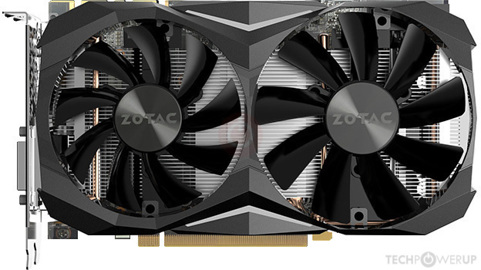- Joined
- Dec 25, 2020
- Messages
- 8,342 (5.24/day)
- Location
- São Paulo, Brazil
| Processor | 13th Gen Intel Core i9-13900KS |
|---|---|
| Motherboard | ASUS ROG Maximus Z790 Apex Encore |
| Cooling | Pichau Lunara ARGB 360 + Honeywell PTM7950 |
| Memory | 32 GB G.Skill Trident Z5 RGB @ 7600 MT/s |
| Video Card(s) | Palit GameRock GeForce RTX 5090 32 GB |
| Storage | 500 GB WD Black SN750 + 4x 300 GB WD VelociRaptor WD3000HLFS HDDs |
| Display(s) | 55-inch LG G3 OLED |
| Case | Cooler Master MasterFrame 700 benchtable |
| Power Supply | EVGA 1300 G2 1.3kW 80+ Gold |
| Mouse | Microsoft Classic IntelliMouse |
| Keyboard | IBM Model M type 1391405 |
| Software | Windows 10 Pro 22H2 |
"SFF" and a 300mm long GPU is a combo which just doesn't come up first to my mind.
Shouldn't a SFF have something like an ITX board with an "ITX" version of a card?
edit: Like the legendary Zotac GTX 1080 Ti Mini.

ZOTAC GTX 1080 Ti Mini Specs
NVIDIA GP102, 1620 MHz, 3584 Cores, 224 TMUs, 88 ROPs, 11264 MB GDDR5X, 1376 MHz, 352 bitwww.techpowerup.com
I know a guy that had one of these. He shunt modded and killed it

Maybe if it's 300mm and single slot, like Galax 1070 Katana

When ITX GPU?
I want an ITX / low length/single fan RTX 4070 with 16GB VRAM. (Or rather something like the 1080Ti mini for the 4070Ti (Super/16GB VRAM)) It's ~200W just like the numerous ITX 1080/2070(S)/3060Ti, all ~1 "Liter" in size, so ~200 "Watt per Liter" We should be getting better/more...www.techpowerup.com
The Katana was an unusual card, but I don't think any of these are ever coming back. Instead, they're changing the design of the cases so you can vertically mount the cards and make better use of the volume within. TPU has reviewed many if not most of the "certified" designs and they're not necessarily ITX either, seems like NVIDIA was targeting sub-35 liter volume for the program.
Look at the ASUS case for example, TPU review from 2022:

Asus Prime AP201 Review
Don't be fooled by the fact that the Asus Prime AP201 is an M-ATX case. In fact, it may well be the reason you end up going for that type of motherboard instead of the classic ATX or ITX options out there. The AP201 manages to impress all around with its simple, yet functional, very balanced...
The even more compact, ITX-only Fractal Design Terra (which is my favorite of the bunch) was also reviewed this year:

Fractal Design Terra Review
The Fractal Design Terra is not your usual SFF chassis. While it does have all the fixings of a sandwich-style ITX case with lots of engineering details, the clear focus is the amazing material mix of aluminium and wood, color choices and design above all else.
If you see something in common between these micro-ATX and mini-ITX formats is that they all have a vertical GPU mount that maximizes the utilization of the compact space, in a very very similar way








